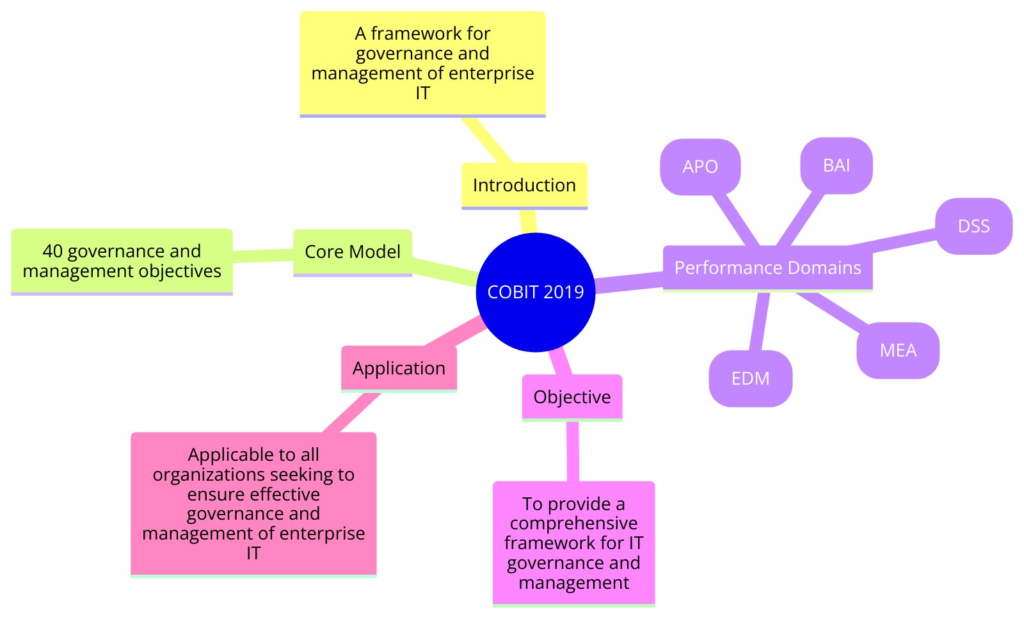Cobit 2019
COBIT (Control Objectives for Information and Related Technologies) 2019 is the latest iteration of the globally recognized framework for enterprise IT governance and management. Originally introduced by ISACA (Information Systems Audit and Control Association), COBIT provides comprehensive guidelines, practices, and analytical tools to help organizations ensure their IT systems and processes align with their strategic objectives, manage risks, and optimize resources.
What is COBIT 2019?
COBIT 2019 builds upon the foundation laid by its predecessors by incorporating the latest developments in enterprise IT, including advancements in technology, trends in business management, and evolving regulatory requirements. It offers a more flexible and customizable framework that acknowledges the unique needs and circumstances of each organization. COBIT 2019 is designed not just for IT professionals but also for auditors, business managers, and leaders who aim to make informed decisions about IT investments, risk management, and value creation.
Origin of the Framework
COBIT was first developed in the 1990s, with its initial release aimed primarily at IT auditors seeking guidance on technology control objectives. Over the years, it has evolved through several iterations, broadening its scope to encompass all aspects of IT governance and management. COBIT 2019 represents the most current and comprehensive version, reflecting ISACA’s ongoing commitment to providing up-to-date and globally relevant standards for IT governance.
How It Works
COBIT 2019 is structured around a core model of 40 governance and management objectives, classified into six performance domains: Align, Plan, and Organize; Build, Acquire, and Implement; Deliver, Service, and Support; Monitor, Evaluate and Assess; and Governance. These domains cover the end-to-end IT business process and are supported by a comprehensive set of management practices and activities.
Key components of COBIT 2019 include:
- Governance and Management Objectives: Each of the 40 objectives is detailed with a complete set of components, including processes, policies, and metrics.
- Performance Management: A system to evaluate and monitor the performance of IT governance and management.
- Design Factors: A set of criteria to tailor the COBIT system to the organization’s needs, considering factors like enterprise strategy, risk profile, and technological context.
- Focus Areas: Specific scenarios or challenges within IT governance that COBIT can address, providing targeted guidance.
Why It Is Valuable
COBIT 2019 offers several benefits for organizations seeking to improve their IT governance, including:
- Alignment of IT and Business Goals: Ensures IT processes and investments are closely aligned with strategic objectives.
- Risk Management: Provides a structured approach to identifying, managing, and mitigating IT-related risks.
- Regulatory Compliance: Helps organizations meet legal and regulatory requirements related to IT.
- Efficiency and Effectiveness: Promotes the optimal use of IT resources and processes, improving service delivery and value generation.
- Adaptability: Offers a customizable framework that can adapt to changes in business, technology, or regulatory environments.
When and How to Use It
COBIT 2019 can be used by organizations of all sizes and sectors to enhance their IT governance and management practices. It is particularly useful for:
- Designing and implementing IT governance frameworks from scratch or assessing and improving existing ones.
- Preparing for and achieving compliance with various IT-related regulations and standards.
- Supporting strategic decision-making and risk management efforts in IT investments and operations.
Implementing COBIT 2019 typically involves:
- Assessing the current state of IT governance and management against COBIT’s standards.
- Identifying gaps and areas for improvement.
- Designing and implementing a tailored governance framework based on COBIT’s principles and practices.
- Continuously monitoring and adjusting the framework to align with organizational changes and external developments.
Shortcomings/Criticisms
While COBIT 2019 is highly regarded for its comprehensive approach to IT governance, it faces some criticisms:
- Complexity: The depth and breadth of the framework can be overwhelming, especially for smaller organizations with limited resources.
- Implementation Cost: The cost of fully implementing COBIT practices, including training and tool acquisition, can be significant.
- Rapid Technological Change: Keeping the framework up to date with the fast pace of technological innovation can be challenging, possibly leaving gaps in governance practices.
COBIT 2019 offers a robust and versatile framework for achieving effective IT governance and management. Its comprehensive guidelines and tools support organizations in aligning IT operations with business objectives, managing risks, and ensuring regulatory compliance. However, successful implementation requires careful planning, adequate resources, and ongoing commitment to adapt the framework to the organization’s changing needs.


